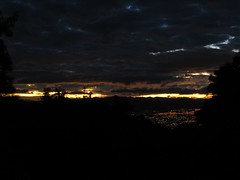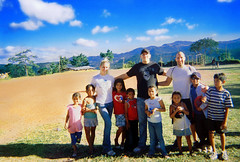Tegucigalpa
Tegucigalpa (English: /tɛˌɡsᵻˈɡælpə/, English: /təˌ-/, Spanish: [teɣusiˈɣalpa]), formally Tegucigalpa, Municipality of the Central District (Spanish: Tegucigalpa, Municipio del Distrito Central or Tegucigalpa, M.D.C.), and colloquially referred to as Tegus or Teguz, is the capital and largest city of Honduras along with its sister city, Comayagüela.
Claimed on 29 September 1578 by the Spaniards, Tegucigalpa became the country's capital on October 30, 1880, under President Marco Aurelio Soto, when he moved the capital from Comayagua. The Constitution of Honduras, enacted in 1982, names the sister cities of Tegucigalpa and Comayagüela as a Central District to serve as the permanent national capital, under articles 8 and 295.
After the dissolution of the Federal Republic of Central America in 1841, Honduras became an individual sovereign nation with Comayagua as its capital. The capital was moved to Tegucigalpa in 1880. On January 30, 1937, Article 179 of the 1936 Honduran Constitution was changed under Decree 53 to establish Tegucigalpa and Comayagüela as a Central District.
Tegucigalpa is located in the southern-central highland region known as the department of Francisco Morazán of which it is also the departmental capital. It is situated in a valley, surrounded by mountains. Tegucigalpa and Comayagüela, being sister cities, are physically separated by the Choluteca River. The Central District is the largest of the 28 municipalities in the Francisco Morazán department.
Tegucigalpa is Honduras' largest and most populous city as well as the nation's political and administrative center. Tegucigalpa is host to 25 foreign embassies and 16 consulates. It is the home base of several state-owned entities such as ENEE and Hondutel, the national energy and telecommunications companies, respectively. The city is also home to the country's most important public university, the National Autonomous University of Honduras, as well as the national soccer team. The city is served by two international airports, Comayagua and Toncontín.
The Central District Mayor's Office (Alcaldia Municipal del Distrito Central) is the city's governing body, headed by a mayor and 10 aldermen forming the Municipal Corporation (Corporación Municipal). Being the department's seat as well, the governor's office of Francisco Morazán is also located in the capital. In 2008, the city operated on an approved budget of 1.555 billion lempiras (US$82,189,029). In 2009, the city government reported a revenue of 1.955 billion lempiras (US$103,512,220), more than any other capital city in Central America except Panama City.
Tegucigalpa's infrastructure has not kept up with its population growth. Deficient urban planning, densely condensed urbanization, and poverty are ongoing problems. Heavily congested roadways, where road infrastructure is unable to efficiently handle over 400,000 vehicles, create havoc on a daily basis. Both national and local governments have taken steps to improve and expand infrastructure as well as to reduce poverty in the city.
Etymology
Most sources indicate the origin and meaning of the word Tegucigalpa is derived from the Nahuatl language. The most widely accepted version suggests that it comes from the Nahuatl word Taguz-galpa, which means "hills of silver", but this interpretation is uncertain since the natives who occupied the region at the time were unaware of the existence of mineral deposits in the area.
Another source suggests that Tegucigalpa derives from another language in which it means painted rocks, as explained by Leticia Oyuela in her book Minimum History of Tegucigalpa. Other theories indicate it may derive from the term Togogalpa, which refers to tototi (meaning a small green parrot, in Nahuatl) and Toncontín, a small town near Tegucigalpa (toncotín was a Mexican dance of Nahuatl origin).
In Mexico, it is believed the word Tegucigalpa is from the Nahuatl word Tecuztlicallipan, meaning "place of residence of the noble" or Tecuhtzincalpan, meaning "place on the home of the beloved master".
Honduran philologist Alberto de Jesús Membreño wrote in his book Indigenous Toponymies of Central America that he thinks Tegucigalpa is a Nahuatl word meaning "in the homes of the sharp stones" and rules out the traditional meaning "hills of silver" arguing that Taguzgalpa was the name of the ancient eastern zone of Honduras.
History
Tegucigalpa was founded by Spanish settlers as Real de Minas de San Miguel de Tegucigalpa on September 29, 1578 on the site of an existing native settlement of the Lenca and Tolupans. The first mayor of Tegucigalpa was Juan de la Cueva, who took office in 1579. The Dolores Church (1735), the San Miguel Cathedral (1765), the Casa de la Moneda (1780), and the Immaculate Conception Church (1788) were some of the first important buildings constructed.
Almost 200 years later, on June 10, 1762, this mining town became Real Villa de San Miguel de Tegucigalpa y Heredia under the rule of Alonso Fernández de Heredia, then-acting governor of Honduras. The late 18th and early 19th centuries saw disruption in Tegucigalpa's local government, from being extinguished in 1788 to becoming part of Comayagua in 1791 to returning to self-city governance in 1817.
In 1817, then-Mayor Narciso Mallol started the construction of the first bridge, a ten-arch masonry, connecting both sides of the Choluteca River. Upon completion four years later, it linked Tegucigalpa with her neighbor city of Comayagüela. In 1821, Tegucigalpa legally became a city. In 1824, the first Congress of the Republic of Honduras declared Tegucigalpa and Comayagua, then the two most important cities in the country, to alternate as capital of the country.
After October 1838, following Honduras' independence as a single republic, the capital continued to switch back and forth between Tegucigalpa and Comayagua until October 30, 1880, when Tegucigalpa was declared the permanent capital of Honduras by then-president Marco Aurelio Soto. A popular myth claims that the society of Comayagua, the long-time colonial capital of Honduras, publicly disliked the wife of President Soto, who took revenge by moving the capital to Tegucigalpa. A more likely theory is that the change took place because President Soto was an important partner of the Rosario Mining Company, an American silver mining company, whose operations were based in San Juancito, close to Tegucigalpa, and he needed to be close to his personal interests.
By 1898, it was decided that both Tegucigalpa and Comayagüela, being neighbor cities on the banks of the Choluteca River, would form the capital, but with separate names and separate local governments. During this period, both cities had a population of about 40,000 people.
Between the 1930s and 1960s, Tegucigalpa continued to grow reaching a population of over 250,000 people, giving way to what would become one of the biggest neighborhoods in the city, the Colonia Kennedy; the nation's autonomous university, the UNAH; and the construction of the Honduras Maya Hotel. It still remained relatively small and provincial until the 1970s, when migration from the rural areas began in earnest. During the 1980s, several avenues, traffic overpasses, and large buildings were erected, a relative novelty to a city characterized until then by two-story buildings. However, lacking the enforcement of city planning and zoning laws, it led to highly disorganized urbanization. This lack of proper urbanization as the population has grown is evident on the surrounding slopes of the several hills in the city where some of the city's most impoverished neighborhoods have prevailed.
On October 30, 1998, Hurricane Mitch devastated the capital, along with the rest of Honduras. For five days, Mitch pounded the country creating devastating landslides and floods, causing the death of thousands as well as heavy deforestation and the destruction of thousands of homes. A portion of Comayagüela was destroyed along with several neighborhoods on both sides of the Honduran capital. After the hurricane, infrastructure in Tegucigalpa was severely damaged. Even 12 years later, remnants of Hurricane Mitch were still visible, especially along the banks of the Choluteca River.
Today, Tegucigalpa continues to sprawl far beyond its former colonial core: towards the east, south and west, creating a large but disorganized metropolis. In an effort to modernize the capital, increase its infrastructure and improve the quality of life of its inhabitants, the administration has passed several ordinances and projects to turn the city around within the upcoming years.
Geography
Tegucigalpa is located on a chain of mountains with elevations of at its lowest points and at its highest suburban areas. Like most of the interior highlands of Honduras, the majority of Tegucigalpa's current area was occupied by open woodland. The area surrounding the city continues to be open woodland supporting pine forest interspersed with some oak, scrub, and grassy clearings as well as needle leaf evergreen and broadleaf deciduous forest.
The metropolitan area of both Tegucigalpa and Comayagüela covers a total area of while the entire Municipality of the Central District covers a total area of . Geological faults that are a threat to the neighborhoods on and below the hill have been identified in the District's high regions surrounding the capital.
The Choluteca River, which crosses the city from south to north, physically separates Tegucigalpa and Comayagüela. El Picacho Hill, a rugged mountain of moderate height, rises above the downtown area; several neighborhoods, both upscale residential and lower income, are located on its slopes. The city consists of gentle hills, and the ring of mountains surrounding the city tends to trap pollution. During the dry season, a dense cloud of smog lingers in the basin until the first rains fall.
Tucked into a valley and bisected by a river, Tegucigalpa is prone to flooding during t…
Looking for places related to Tegucigalpa?
Those are other destinations to find places related to Tegucigalpa:




















